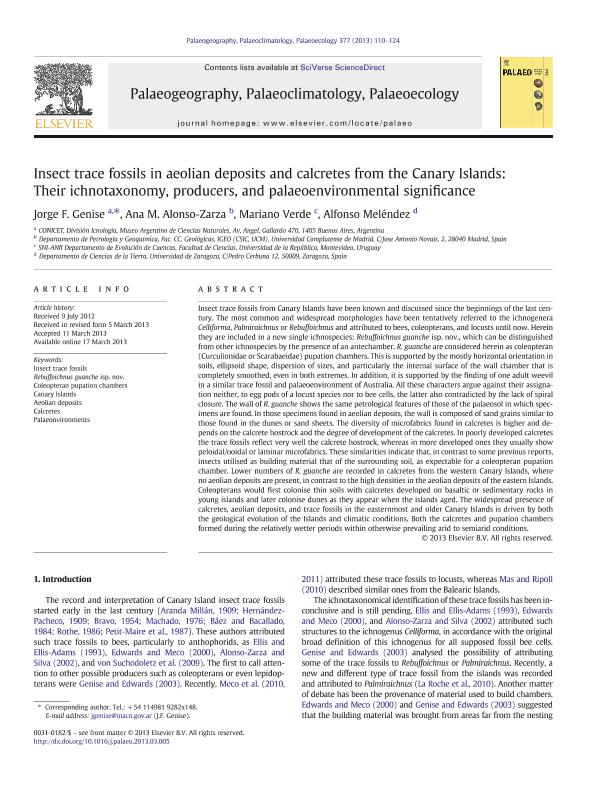Mostrar el registro sencillo del ítem
dc.contributor.author
Genise, Jorge Fernando

dc.contributor.author
Alonso Zarza, Ana M.
dc.contributor.author
Verde, Mariano
dc.contributor.author
Melendez, Alfonso
dc.date.available
2015-12-21T17:54:27Z
dc.date.issued
2013-05-01
dc.identifier.citation
Genise, Jorge Fernando; Alonso Zarza, Ana M.; Verde, Mariano; Melendez, Alfonso; Insect trace fossils in aeolian deposits and calcretes from the Canary Islands: Their ichnotaxonomy, producers, and palaeoenvironmental significance; Elsevier Science; Palaeogeography, Palaeoclimatology, Palaeoecology; 377; 1-5-2013; 110-124
dc.identifier.issn
0031-0182
dc.identifier.uri
http://hdl.handle.net/11336/3113
dc.description.abstract
Insect trace fossils from Canary Islands have been known and discussed since the beginnings of the last century. The most common and widespread morphologies have been tentatively referred to the ichnogenera Celliforma, Palmiraichnus or Rebuffoichnus and attributed to bees, coleopterans, and locusts until now. Herein they are included in a new single ichnospecies: Rebuffoichnus guanche isp. nov., which can be distinguished from other ichnospecies by the presence of an antechamber. R. guanche are considered herein as coleopteran (Curculionidae or Scarabaeidae) pupation chambers. This is supported by the mostly horizontal orientation in soils, ellipsoid shape, dispersion of sizes, and particularly the internal surface of the wall chamber that is completely smoothed, even in both extremes. In addition, it is supported by the finding of one adult weevil in a similar trace fossil and palaeoenvironment of Australia. All these characters argue against their assignation neither, to egg pods of a locust species nor to bee cells, the latter also contradicted by the lack of spiral closure. The wall of R. guanche shows the same petrological features of those of the palaeosol in which specimens are found. In those specimens found in aeolian deposits, the wall is composed of sand grains similar to those found in the dunes or sand sheets. The diversity of microfabrics found in calcretes is higher and depends on the calcrete hostrock and the degree of development of the calcretes. In poorly developed calcretes the trace fossils reflect very well the calcrete hostrock, whereas in more developed ones they usually show peloidal/ooidal or laminar microfabrics. These similarities indicate that, in contrast to some previous reports, insects utilised as building material that of the surrounding soil, as expectable for a coleopteran pupation chamber. Lower numbers of R. guanche are recorded in calcretes from the western Canary Islands, where no aeolian deposits are present, in contrast to the high densities in the aeolian deposits of the eastern Islands. Coleopterans would first colonise thin soils with calcretes developed on basaltic or sedimentary rocks in young islands and later colonise dunes as they appear when the islands aged. The widespread presence of calcretes, aeolian deposits, and trace fossils in the easternmost and older Canary Islands is driven by both the geological evolution of the Islands and climatic conditions. Both the calcretes and pupation chambers formed during the relatively wetter periods within otherwise prevailing arid to semiarid conditions.
dc.format
application/pdf
dc.language.iso
eng
dc.publisher
Elsevier Science

dc.rights
info:eu-repo/semantics/openAccess
dc.rights.uri
https://creativecommons.org/licenses/by-nc-nd/2.5/ar/
dc.subject
Insect Trace Fossils
dc.subject
Rebuffoichnus Guanche
dc.subject
Coleopteran Pupation Chambers
dc.subject
Canary Islands
dc.subject.classification
Paleontología

dc.subject.classification
Ciencias de la Tierra y relacionadas con el Medio Ambiente

dc.subject.classification
CIENCIAS NATURALES Y EXACTAS

dc.title
Insect trace fossils in aeolian deposits and calcretes from the Canary Islands: Their ichnotaxonomy, producers, and palaeoenvironmental significance
dc.type
info:eu-repo/semantics/article
dc.type
info:ar-repo/semantics/artículo
dc.type
info:eu-repo/semantics/publishedVersion
dc.date.updated
2016-03-30 10:35:44.97925-03
dc.journal.volume
377
dc.journal.pagination
110-124
dc.journal.pais
Países Bajos

dc.journal.ciudad
Amsterdam
dc.description.fil
Fil: Genise, Jorge Fernando. Consejo Nacional de Investigaciones Científicas y Técnicas. Oficina de Coordinación Administrativa Parque Centenario. Museo Argentino de Ciencias Naturales; Argentina
dc.description.fil
Fil: Alonso Zarza, Ana M.. Universidad Complutense de Madrid; España
dc.description.fil
Fil: Verde, Mariano. Universidad de la República; Uruguay
dc.description.fil
Fil: Melendez, Alfonso. Universidad de Zaragoza; España
dc.journal.title
Palaeogeography, Palaeoclimatology, Palaeoecology

dc.relation.alternativeid
info:eu-repo/semantics/altIdentifier/url/http://www.sciencedirect.com/science/article/pii/S0031018213001259
dc.relation.alternativeid
info:eu-repo/semantics/altIdentifier/doi/http://dx.doi.org/10.1016/j.palaeo.2013.03.005
Archivos asociados
